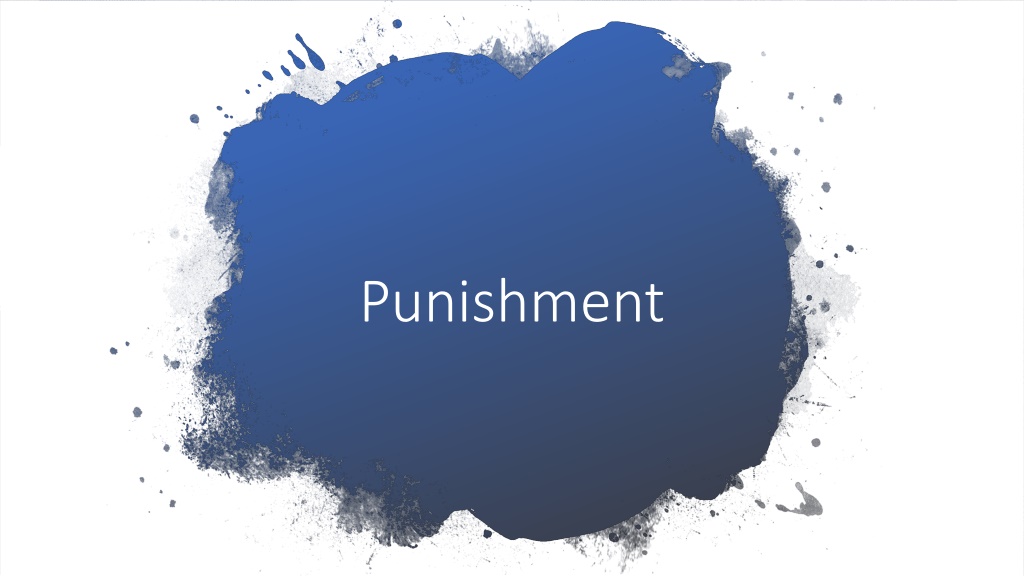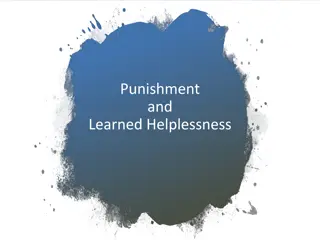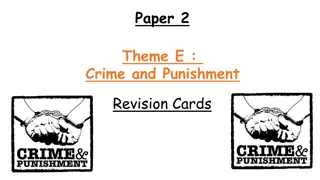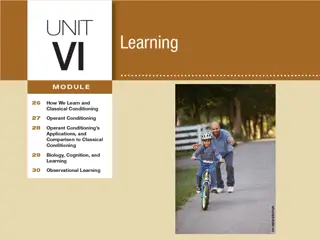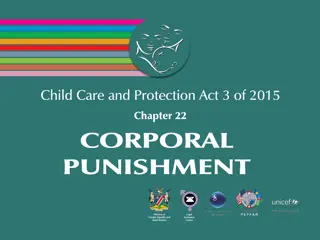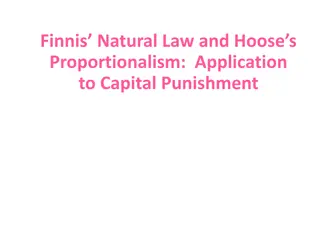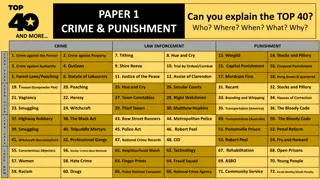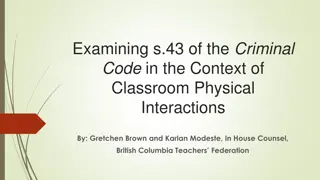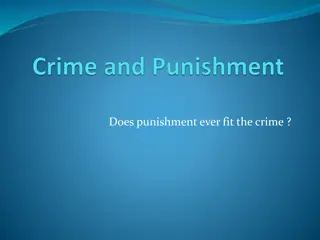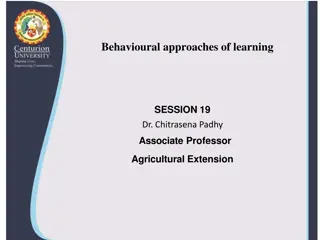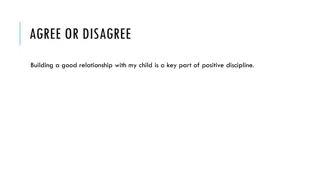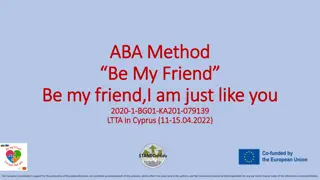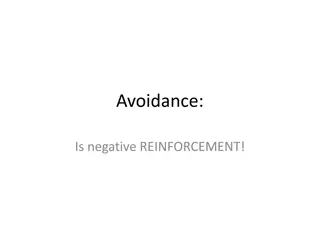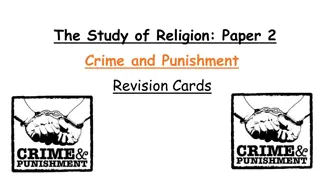Understanding Punishment in Operant Behavior
Aversive stimuli can influence operant behavior through noncontingent punishment, as seen in conditioned emotional responses like conditioned suppression. The threat of upcoming aversive events can reduce responding, highlighting the importance of conditioned emotional responses. Punishment operates in conjunction with reinforcement, emphasizing the need for an alternate, reinforced response for effective punishment.
Download Presentation

Please find below an Image/Link to download the presentation.
The content on the website is provided AS IS for your information and personal use only. It may not be sold, licensed, or shared on other websites without obtaining consent from the author. Download presentation by click this link. If you encounter any issues during the download, it is possible that the publisher has removed the file from their server.
E N D
Presentation Transcript
Aversive stimuli can also affect operant behavior when given noncontingently That is, a targeted behavior neither produces nor prevents the punisher when aversive stimuli occur independently of responding. Aversive but not contingent? Most famous example is conditioned emotional response (CER)
Conditioned Emotional Response Conditioned Emotional Response (CER) (CER) Basic set up: Rat must lever press to obtain food. Rat receives periodic pairings of tone with electric shock. (tone signals the shock) Rat eventually press lever at a lower rate when tone is on than when it is off. Phenomenon is called conditioned suppression or conditioned emotional response (CER; Estes & Skinner, 1941).
The threat of an upcoming aversive event can decrease responding Even when noncontingent Unpredictability produces GREAT CERs Because the aversive event is likely, organism prepares or gets ready for the event Why are CER s important? Can be cued or uncued Really gets in the way of ongoing responses E.g., in dog training: if dog is afraid of being punished Rate of overall responding goes down Animal is afraid of punisher, so doesn t risk behaving
Is all we learned about positive reinforcement true, in mirror-image form, of punishment? Yes and no. Are some additional characteristics of punishment Parameters of Punishment Any operant punishment situation is really a punishment plus reinforcement situation. Just like any reinforcement situation =Sr + P If get punished, don t get the reinforcer. If get the reinforcer, don t get punished.
For punishment to suppress operant responding, responses must already be occurring with some frequency. For responses to occur, they must be producing reinforcement. Punishment + Reinforcement? So, effect of punishment reflects interaction of two contingencies-- reinforcement and punishment. Jointly operate in most situations.
Punishing only reinforced response is often not an effective procedure. Suppresses many responses Doesn t provide a replacement response Punishment Effectiveness If you give organism an alternative, unpunished route to reinforcement, then effects of punishment are enhanced. Always shape an incompatible response! A response that is the opposite of the inappropriate response E.g., punish getting out of seat but reinforce sitting in seat
As intensity of punishing stimulus increases, degree of suppression increases. Punishment Intensity: If very intense shock is used, then suppression may be virtually complete. Partially due to physiological effects; partially due to contingency effects
Experience with the punisher is important If never experienced shock, don t know it hurts! Punishment effects are relative: What has been prior experience and how is the punisher COMPARED to previous punishers? Role of past experience! Lots of research showing this: Suppressive effect of intermediate shock intensity depends on animal s past experience with shock. If animal has experienced intensities going from mild to intermediate, then there will be little suppression. If animal has experienced intensities going from severe to intermediate, then there will be substantial suppression.
For punishment to be maximally effective, it must immediately follow operant response. Immediate is Best! As delay interval between response and punishment increases, amount of suppression decreases. Too many other behaviors can occur between R and P; contingency not as effective when initially using P
Initially: Should be certain and follow each operant response. Probability of punishment should be 1.0 When responses are punished intermittently, effectiveness of punishment procedure is reduced. Probability of a punisher Can shape towards partial schedule of punishment Is this different than what observe with reinforcement? Think about it!
When punishment is discontinued, suppressive effects on responding ARE not permanent Recovery from Punishment: Extinction The rate of responding after punishment is discontinued will not only recover But briefly exceed level at which it was occurring prior to punishment Opposite of extinction burst Is this really surprising?
Unconditioned punisher: stimulus whose presentation functions as punishment without having been paired with any other punishers. Innate Biologically relevant Still, all organisms not respond the same! Unconditioned Punishers Unconditioned punishers will suppress any behavior that precedes their onset. Again, is this similar to reinforcement?
How are Conditioned Punishers different? Acquires capability to function as punisher through stimulus-stimulus pairing with one or more unconditioned or conditioned punishers. Conditioned punisher is a stimulus that functions as punishment as a result of a person s conditioning history. Using the name to correct behavior makes the name a poisoned cue E.g., the word no is a conditioned stimulus A child s name can become a punisher!!!!
If responses occur in absence of punisher, the response will return, potentially to pre-punishment levels Extinction of Conditioned Punishers If the conditioned punisher is repeatedly presented without the punisher with which it was initially paired, effectiveness as punishment will diminish until it is no longer a punisher.
Generalization and Discrimination Stimulus that has been paired with numerous forms of unconditioned and conditioned punishers becomes a generalized conditioned punisher. Stimulus that has been paired with only one specific conditioned or unconditioned punisher becomes a discriminated punisher.
Schedule or frequency of punishment Continuous punishment schedules knock down behavior more quickly Partial punishment schedules keep behavior suppressed more effectively Other factors influencing effectiveness of punishment: Availability of reinforcement for the target behavior Must eliminate inadvertent sources of reinforcement for your behavior targeted for punishment Teacher may punish, but the other kids may keep reinforcing class clown behavior Availability of reinforcement for an alternative behavior. Punishment more effective if reinforce the opposite behavior Again, must give organism alternative path to the reinforcer that was maintaining the unwanted behavior
Reflexive aggression: When punished, act out aggressively Is called reflexive because appears to be innate When in pain, you bite! Punishment can lead to Aggression Operant Aggression Learn to be aggressive contingently retaliatory
Aggression may model aggression That is, aggression breeds aggression Use of aggression as punishment may provide model of how to solve problems Punishment and Aggression Social Disruption The person who delivers the punishment/situation in which punishment occurs become tainted Poisoning cues Also called social disruption: Behavior is disrupted in presence of cues that predict punishment May get freezing, reduced effort, etc., in presence of punisher
Yes, by definition it is a negative punisher Losing the opportunity to get reinforcement from many other sources Again, to be effective, must really isolate so can t get reinforced. Is Time Out a Punisher? Time out is not isolation Time out is brief, focused and contingent Isolation is of long duration, often noncontingent, and often not effective.
1 minute per year of age Not really effective for children under 6-9 mos For really little ones, VERY brief withdrawal of attention Rules for Using Time- Out Must be quiet to get the timer to start Cannot use for dangerous, disruptive or self-stimulatory behavior Must really be time out from other rewards
Response cost: your response costs you something or some behavior Negative Punishment OVERCORRECTION: two parts Restitution: reinstatement of environment (clean up) Positive practice: practice better response for situation Can also use satiation/habituation
Severe self injurious behavior (SIB) If Punishment If Punishment is so bad, why is so bad, why would a would a behavioral behavioral therapist use therapist use it? it? Examples: Examples: Highly aggressive behavior to others Running into the street Behavior which creates in immediate danger for self or others Pulling a hot pan off the stove
Behavior must be (immediately) dangerous to person or others Rate of responding is so high that there is NO chance to interrupt and reinforce good behavior Guidelines for using positive punishment Must have tried other alternatives An example: https://www.youtube.com/watch?v=spuMFceTZGo https://www.youtube.com/watch?v=spuMFceTZGo https://www.youtube.com/watch?v=hLSEy_p--i8 https://www.youtube.com/watch?v=hLSEy_p--i8 http://www.youtube.com/watch?v=13UcT1FVVts http://www.youtube.com/watch?v=13UcT1FVVts
